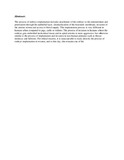| dc.description.abstract | The process of embryo implantation includes attachment of the embryo to the endometrium and penetration through the epithelial layer, decidualization of the basement membrane, invasion of the uterine stroma and access to blood supply. This implantation process is very different in humans when compared to pigs, cattle or rodents. The process of invasion in humans where the embryo gets embedded in decidual tissue and in spiral arteries is more aggressive, but otherwise similar to the process of implantation and invasion in non-human primates such as rhesus monkeys and baboons. For ethical reasons, it is unacceptable to study directly the process of embryo implantation in women, and to this day, this remains one of the ‘black boxes’ of reproductive science. Indeed for many clinicians practicing reproductive medicine, in fertility centers, the most difficult question and of concern asked by patients is: ‘Why do my healthy appearing embryos not implant: is there a problem with my endometrium or uterus?’ The olive baboon (Papio anubis anubis) is an excellent animal model for reproductive research. In contrast with smaller non-human primates like rhesus monkeys or cynomolgus monkeys, it is possible in baboons to use transcervical uterine probes (curettes, catheters and hysteroscopic equipment) to perform endometrial biopsy, embryo flushing or transfer and hysteroscopy in a non-invasive way. This can be done easily in multiparous baboons during menstruation, but may be more difficult at the end of the follicular phase (maximal perineal swelling impedes vaginal/cervical access) or during the luteal phase (narrow cervix), in nulliparous baboons and in animals with abnormal internal genitals. In this paper we present an overview regarding the potential of the baboon model to study in vivo uterine receptivity and embryo implantation using invasive and non-invasive approaches. | en |

